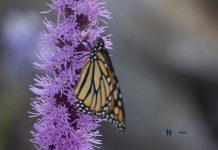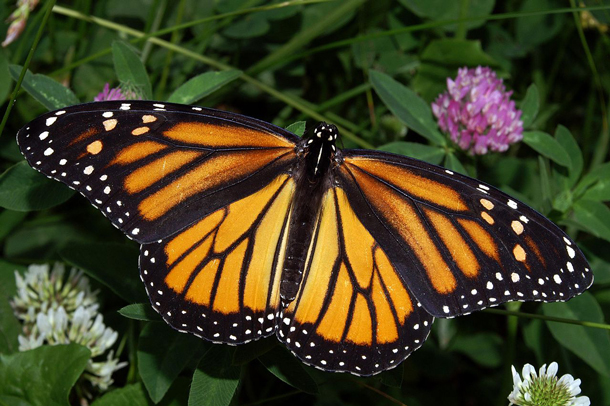
Coconut Grove, Florida – LIVING – Much has been written about the strength, optimism and natural vitality a butterfly, as a wild creature, in these Tropics needs to survive. As well the stages a butterfly must go through as it abandons its cocoon, crawling out as a caterpillar, searching for food, then shedding several layers of itself in going through its ‘instar’ stages before morphing into a colourful creature. Every set piece is so brilliantly remarkable. It was the English philosopher Malcolm Muggeridge who used a metaphor about caterpillars as an Educational source of inspiration. Muggeridge would relate how–imaginarily–in a host of slow moving caterpillars one of them, with an artistic bent, paused one day. Gazed around at his fellow crawlers and muckers saying, “don’t ever quit. Cuz, one day we’ll fly.”
Muggeridge once repeated that affirmative touch of philosophy while on tour one year during my college days. He was touring the Land a Down a Under on a tour of Australia being hosted on International Tv. It has always stayed with me as one of those vignettes that so captivated us back in time. Another reflection on the future road all caterpillars reveal to others is told by Charles Darwin in one of his first books. Darwin, on the ship the Beagle, had docked for a time in Chile. There as a Naturalist he searched others in his field. Soon finding that, in 1830, another scientist had once been arrested for telling others, in a remote area, how he could illustrate how caterpillars would eventually live out their lives. They would morph from a cocoon stage and eventually be “free falling, free flying” (to quote Florida’s Tom Petty’s song) elegantly coloured creatures. They would, in effect, go from their beginnings on earth to spaces in the sky like birds Back then, he was tried for weaving a false truth. Accused of heresy. Though later set free. This fascinating tale is an example however of the outright fascination the cycles of life butterflies symbolize. One sees this facet in the amazement of every trekker, photographer, biologist, researcher, artist, or musician, who wanders to this Coconut River setting.
Besides, while enjoying the vastness of it all, a quote I once wrote in Holland as a student. It was Aart Van Der Leeuw who said, “the mystery of Life is not a problem to be solved. It is a reality to be experienced.” To share in my story something of the joy of what a butterfly captures in human hearts is very evident in the writings and thoughts of others. Nathaniel Hawthorne believed, “happiness is a butterfly, which when pursued is always just beyond just your grasp. But which if you will sit down quietly may alight upon you.”
Einstein, the world ‘s genius, and accomplished musician, professed there are “two ways to live. One is that nothing is a miracle. The other, as though everything is a miracle.” John Keats, wrote long ago, to Fawney Browne his love, “I almost wish we were butterflies and lived but three summer days. Such days with you I could fill with more delight than fifty common years.” One, from Japan, at this Museum was jubilant. And was overheard saying, “so many hundreds of butterflies in and out of sight all the time. Such short lived pictures in a stream of consciousness. Without beginning and end. Another naturalist, from Arizona, viewing what was before us said she thought, “butterflies were really self propelled flowers.” Quite so.
There is also a time honoured so called ‘animal symbolism’ with butterflies. Humans in all parts of the world have adored their journey of tracing their genesis inside the form of a cocoon. Subsequently undergoing transformations that are unmatched on earth. Because the DNA in a butterfly cocoon is completely different than its DNA as winged creature. That is uniquely their story and theirs alone.
A university tour guide Said to us, as she must have to hundreds of others, “I mean, it’s just abundantly brilliant. Really, phenomenal.” Making a teaching point, pausing, pointing to the horizon outside, “almost the effect of a gorgeous sunrise or sunset. Leaving you in awe. But never two the same.”
During our Safari, a young elementary student stopped. resting on the bench where we were in the
aviary. So many with resident butterflies and hummingbirds in eye catching sequences.
A page in her notebook showed a new theme of words denoting her study of butterflies.
a. BUTTERFLY
in France, they say: p.a.p.i.l.l.o.n.
b. (i) Read about these stages: pupa, cocoon, chrysalis.
(ii) What does metamorphosis mean to you?
c. Do a DRAWING: make a sketch of a butterfly.
d. Ask a visitor what they like about butterflies?
Perhaps a future Scientist in our midst, I thought. Besides those who have dwelt on butterflies in creative writing, and noteworthy ideas, there are two well known painters whose passion with butterflies should enter here. James McNeil Whistler author of the famous painting Whistler’s Mother used a motif signifying a butterfly in signing his work. It’s on his famous painting of his Mother. Actually called Arrangement in Black and Grey. That picture is partly Whistler’s tribute to the Orient, with their long lasting love of butterflies, in the manner Whistler handles the curtain, next his Mother. As Whistler underscores the Far East’s simplicity in colour and form. Whistler certainly gets away with it. His painting, in the Louvre in Paris, was recently estimated to be worth over $ 60 million dollars.
The other notable artist is Vincent Van Gogh who completed almost a dozen canvases with a butterfly, or textured moth, in his compositions. Fairly amazing as Vincent’s life as a painter encompassed only a decade.
What a bonus to my trekking as a collection of students about to perform a stage play of Madam Butterfly were present. As was a very dynamic young student’s Operatic group.They would take up a call to dance from their instructor – in pantomime flourishes–along the pathways in the Museum.
At day’s end they drew a collective spontaneous applause as they dramatically trooped out the exit into the open spaces of a very green park where colourful flowers awaited them. The effect was magical. Such a distinguished finale to another chapter in the life of this incredible Butterfly Museum’s philosophy where the second letter in our alphabet represents a ‘B’ for butterflies.
Where hosts of weekly visitors would also inscribe a large ‘B’ in a guest book. Simply saying to themselves, and others, these connections to cycles in a butterfly’s life are just: B.e.a.u.t.i.f.u.l.
Lastly, the former American Opera singer Alma Gluck had a very substantial comparison. Her affinity to all things artistic, during her wonderful career, went this way. “Just as the bird sings or the butterfly soars because it is his natural characteristic. So the artist also works.”
Ronn Hartviksen
NEXT: Ronn Hartviksen goes aquatic. On an Gold Coast Field trip to study amphibians and mammals in the Florida Everglades.


